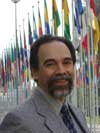| The
international day 12 October 2005 |
|
| The
Secretary-General Message |
|
| Press kit | |
| Conclusion from expert | |
| Events | |
| Media events | |
| Links | |
| Case studies | |
| Other points of view | |
| Announcement | |
 |
|
| Salvano
Briceño, director of the UN/ISDR secretariat “Investing in disaster risk reduction reduces the vulnerability of people to hazards and helps break the vicious cycle of poverty. We need to engage the micro finance community into a dialogue on reducing the impact of natural hazards on populations and livelihoods " "Micro finance is a successful tool to empower women to help reduce their poverty and therefore, their vulnerability to disasters.” |
|
| Press kit | ||
| 2005 Invest to prevent disaster | ||
| Microfinance is a tool that has successfully been utilized to improve livelihood options and reduce poverty. It has hardly been used yet as a tool for reducing risk vulnerability to natural hazards. Leading up to the International Day for Disaster reduction (12 October 2005), the ISDR secretariat will promote dialogue with the microfinance community on the possibility of using these tools to reduce disaster risk and increase community resilience to disasters. | ||
|
||
Microcredit is widely recognized as a useful tool to help reduce
poverty. The possible benefits of microfinance to abate the impact
of natural disasters, however, have not been fully explored. The
new and promising concept of microfinance for disaster reduction
deserves increased attention. As the applicability of the microcredit
is still somewhat experimental, it merits further investigation. |

